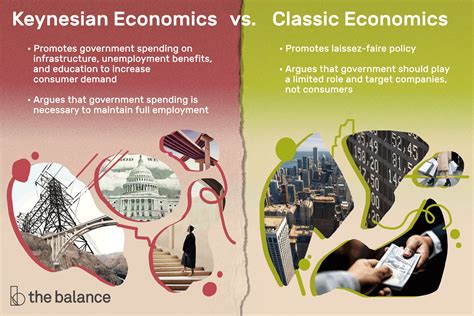Key Concepts
Introduction to Keynesian Economics

Keynesian economics is a macroeconomic theory developed by British economist John Maynard Keynes in the 1930s. It emphasizes the role of aggregate demand (total spending in the economy) in determining economic output, employment, and inflation.
Keynesian Multiplier
One of the central concepts of Keynesian economics is the Keynesian multiplier. This multiplier measures the impact of a change in aggregate demand on national income. The multiplier suggests that an increase in spending leads to a larger increase in income due to the multiplier effect.
Fiscal Policy
Keynesians advocate for using fiscal policy (government spending and taxation) to stimulate aggregate demand during economic downturns. By increasing government spending or reducing taxes, the government can increase the flow of money in the economy and boost economic activity.
Phillips Curve
The Phillips curve is a graphical representation of the relationship between unemployment and inflation. Keynesians believe that an increase in aggregate demand can lead to a reduction in unemployment but may also cause an increase in inflation.
Applications of Keynesian Economics
Stimulating Economic Growth
Keynesian economics has been used to stimulate economic growth during recessions or economic downturns. By reducing taxes, increasing government spending, or providing subsidies to businesses, the government can increase aggregate demand and create jobs.
Reducing Unemployment
Keynesian policies can also reduce unemployment by increasing demand for labor. When aggregate demand increases, businesses need more workers to meet the demand for goods and services, leading to increased hiring.
Controlling Inflation
While Keynesian economics emphasizes stimulating demand, it also recognizes the importance of controlling inflation. Governments can use fiscal policy to reduce aggregate demand and slow down the rate of inflation.
Common Mistakes to Avoid
Overestimating the Multiplier
Policymakers should not overestimate the impact of the Keynesian multiplier. The multiplier effect can be weakened by factors such as savings, imports, and international trade.
Ignoring Supply-Side Effects
Keynesian economics focuses primarily on demand-side factors. However, supply-side factors, such as productivity and technological innovation, can also affect economic growth and inflation.
Excessive Deficit Spending
While fiscal stimulus can be effective in the short term, policymakers must be cautious not to engage in excessive deficit spending over a prolonged period. Excessive borrowing can lead to unsustainable levels of government debt.
FAQs
1. What is the difference between Keynesian economics and monetarism?
Keynesians emphasize the role of aggregate demand while monetarists emphasize the role of the money supply in determining economic activity.
2. What are the limitations of Keynesian economics?
Keynesian economics can underestimate the importance of supply-side factors, overestimate the effectiveness of fiscal policy, and lead to excessive government debt.
3. Can Keynesian economics be used to address stagflation?
Keynesian economics is less effective in addressing stagflation, a combination of high inflation and high unemployment.
4. What are some modern applications of Keynesian economics?
Keynesian ideas have been used in recent economic stimulus packages, such as the American Recovery and Reinvestment Act of 2009.
Conclusion
Keynesian economics provides valuable insights into the role of aggregate demand in the economy. By understanding the principles of Keynesian economics, policymakers can develop effective strategies to stimulate economic growth, reduce unemployment, and control inflation. However, it is important to avoid common mistakes and consider the limitations of Keynesian economics when making policy decisions.
Table 1: The Keynesian Multiplier
| Change in Spending | Change in National Income |
|---|---|
| $100 billion | $250 billion |
Table 2: The Phillips Curve
| Unemployment Rate | Inflation Rate |
|---|---|
| 5% | 2% |
| 4% | 3% |
Table 3: Fiscal Stimulus Measures
| Measure | Impact on Aggregate Demand |
|---|---|
| Tax cuts | Increase |
| Government spending | Increase |
| Subsidies | Increase |
Table 4: Constraints on Keynesian Policy
| Constraint | Description |
|---|---|
| Savings | Some of the increase in spending is saved, reducing the multiplier effect. |
| Imports | Some of the increase in spending is used to buy imported goods, reducing the multiplier effect. |
| International trade | Changes in foreign economic conditions can affect the effectiveness of Keynesian policy. |
